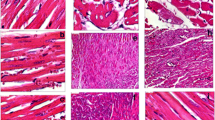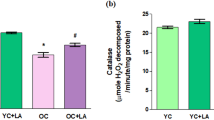Abstract
Objective The reasons for the difference in life expectancy between males and females are still unknown. Previous studies have provided compelling evidence for the presence of oxidized proteins, and lipids in advanced human atherosclerotic lesions. The gender factor responsible for such protein oxidation is unknown and controversial. Our aim was to reveal the difference between myocardial protein and lipid oxidation parameters of male and female aged rats. Methods We investigated the relation between myocardial protein carbonyl (PCO) and other protein oxidation parameters such as advanced oxidation protein products (AOPP), nitrotyrosine (NT), protein hydroperoxide (P-OOH), and protein thiol (P-SH). Our study also covered other oxidative stress parameters, such as total thiol (T-SH), non-protein thiol (Np-SH), 4-hydroxyalkenal (4-HAE), malondialdehyde (MDA), reduced glutathione (GSH), and the glutathione disulfide (GSSG). Results Among the studied parameters, myocardial PCO, AOPP, NT, Np-SH, GSH, Fe2+ levels and the redox index (RI) of male rats were significantly higher than in the female group. On the other hand, P-OOH, P-SH, T-SH, 4-HAE, and MDA levels were all found to be not different. Conclusions These data support the hypothesis that elevated levels of PCO, AOPP, and NT contribute to the extent of protein, but not lipid, oxidation in aged male rats. We are of the conviction that the increased myocardial Np-SH, GSH and RI levels that we have determined in aged male rats may be a protective factor in propagation of protein oxidation. Our findings support our conviction that protein and lipid oxidation, in the myocardial tissue of aged rats, have a controlling role in differing regulating mechanisms through gender differences.





Similar content being viewed by others
References
Alberts B, Johnson A, Lewis J, Raff M, Roberts K, Walter P (2002) In: Molecular biology of the cell. Garland Science Publisher, New York, p 39
Arredondo M, Nunez MT (2005) Iron and copper metabolism. Mol Aspects Med 26:313–327
Barja G (2002) Endogenous oxidative stress: relationship to aging, longevity and caloric restriction. Ageing Res Rev 1:397–411
Beal MF (2002) Oxidatively modified proteins in aging and disease. Free Radic Biol Med 32:797–803
Borrás C, Sastre J, Garcí-Sala D, Lloret A, Pallardó FV, Viña J (2003) Mitochondria from females exhibit higher antioxidant gene expression and lower oxidative damage than males. Free Radic Biol Med 34:546–552
Capéillere-Blandin C, Gausson V, Descamps-Latscha B, Witko-Sarsat V (2004) Biochemical and spectrophotometric significance of advanced oxidized protein products. Biochim Biophys Acta 1689:91–102
Çakatay U, Kayali R, Sivas A, Tekeli F (2005) Prooxidant activities of alpha-lipoic acid on oxidative protein damage in the aging rat heart muscle. Arch Gerontol Geriatr 40:231–240
Dalle-Donne I, Rossi R, Giustarini D, Milzani A, Colombo R (2003) Protein carbonyl groups as biomarkers of oxidative stress. Clin Chim Acta 329:23–38
Davies SMK, Poljak A, Duncan MW, Smythe GA, Murphy MP (2001) Measurements of protein carbonyls, ortho- and meta-tyrosine and oxidative phosphorylation complex activity in mitochondria from young and old rats. Free Radic Biol Med 31:181–190
Du J, Gebicki JM (2004) Proteins are major initial cell targets of hydroxyl free radicals. Int J Biochem Cell Biol 36:2334–2343
Eaton P (2006) Protein thiol oxidation in health and disease: techniques for measuring disulfides and related modifications in complex protein mixtures. Free Radic Biol Med 40:1889–1899
Fernandez-Ballesteros R, Diez-Nicolas J, Ruiz-Torres A (1999) Spain. In: Schroots J, Fernandez-Ballesteros R, Rudinger G (eds) Aging in Europe. IOS press, Amsterdam, pp 107–121
Gay CA, Gebicki JM (2003) Measurement of protein and lipid hydroperoxides in biological systems by the ferric-xylenol orange method. Anal Biochem 315:29–35
Gerontology Research Group [Homepage on the Internet] Los Angeles. [Last updated Jan 24, 2007; Cited Jan 24, 2007] Available from: http://www.grg.org
Humphries KM, Szweda PA, Szweda LI, (2006) Aging: a shift from redox regulation to oxidative damage. Free Radic Res 40:1239–1243
Kallianpur AR (2005) Iron and oxidative injury-A commentary on “Fatty acid-mediated iron translocation: a synergistic mechanism of oxidative injury” by D. Yao et al. Free Radic Biol Med 39:1305–1309
Kalousová M, Zima T, Tesár V, Dusilová-Sulková S, Škrha J (2005) Advanced glycoxidation end products in chronic diseases-clinical chemistry and genetic background. Mutation Res 579:37–46
Kaneda H, Taguchi J, Ogasawara K, Aizawa T, Ohno M (2002) Increased level of advanced oxidation protein products in patients with coronary artery disease. Atherosclerosis 162:221–225
Klatt P, Lamas S (2000) Regulation of protein function by S-glutathiolation in response to oxidative and nitrosative stress. Eur J Biochem 267:4928–4994
Knight JA (2000) The biochemistry of aging. Adv Clin Chem 35:1–62
Lasheras C, Gonzales S, Huerta JM, Braga S, Patterson AM, Fernandez S (2003) Plasma iron is associated with lipid peroxidation in an elderly population. J Trace Elem Med Biol 17:171–176
Pansarasa O, Castagna L, Colombi B, Vecchiet J, Felzani G, Marzatico F (2000) Age and sex differences in human skeletal muscle: role of reactive oxygen species. Free Radic Res 33:287–293
Reznick AZ, Packer L (1994) Oxidative damage to proteins: spectrophotometric method for carbonyl assay. Methods Enzymol 233:357–363
Sameh SA, Xiong C, Lucero J, Behrens MM, Dugan LL, Quick KL (2006) Gender differences in free radical homeostasis during aging: shorter-lived female C57BL6 mice have increased oxidative stress. Aging Cell 5:565–574
Sanz A, Hiona A, Kujoth GC, Seo AY, Hofer T, Kouwenhoven E, Kalani R, Prolla TA, Barja G, Leeuwenburgh C (2007) Evaluation of sex differences on mitochondrial bioenergetics and apoptosis in mice. Exp Gerontol 42:173–182
Sedlak J, Lindsay RH (1968) Estimation of total, protein-bound, and non-protein sulfhydryl groups in tissue with Ellman’s reagent. Anal Biochem 25:192–205
Shacter E (2000) Protein oxidative damage. Methods Enzymol 319:428–436
Škvařilová M, Bulava A, Stejskal D, Adamovská S, Bartek J (2005) Increased level of advanced oxidation products (AOPP) as a marker of oxidative stress in patients with acute coronary syndrome. Biomed Papers 149:83–87
Stadtman ER (2004) Role of oxidant species in aging. Curr Med Chem 11:1105–1112
Valko M, Morris H, Cronin MT (2005) Metals, toxicity and oxidative stress. Curr Med Chem 12:1161–1208
Wilmoth JR, Deegan LJ, Lundstrom H, Horiuchi S (2000) Increase of maximum life span in Sweden, 1861–1999. Science 289:2366–2368
Witko V, Nguyen AT, Descamps-Latscha B (1992) Microtiter plate assay for phagocyte derivered taurine-chloramines. J Clin Lab Anal 6:47–53
Woods AA, Linton SM, Davies MJ (2003) Detection of HOCl-mediated protein oxidation products in the extracellular matrix of human atherosclerotic plaques. Biochem J 370:729–735
Zbikowska HM, Nowak P, Wachowicz B (2006) Protein modification caused by a high dose of gamma irradiation in cryo-sterilized plasma: protective effects of ascorbate. Free Radic Biol Med 40:536–542
Acknowledgements
This work was supported in part by funding from a grant (BYP-1-4/090107) from the Research Fund of the University of Istanbul. We are grateful to Mr. Mithat Esmer for checking the linguistic aspects of this paper.
Author information
Authors and Affiliations
Corresponding author
Rights and permissions
About this article
Cite this article
Kayali, R., Çakatay, U., Uzun, H. et al. Gender difference as regards myocardial protein oxidation in aged rats: male rats have increased oxidative protein damage. Biogerontology 8, 653–661 (2007). https://doi.org/10.1007/s10522-007-9107-5
Received:
Accepted:
Published:
Issue Date:
DOI: https://doi.org/10.1007/s10522-007-9107-5




